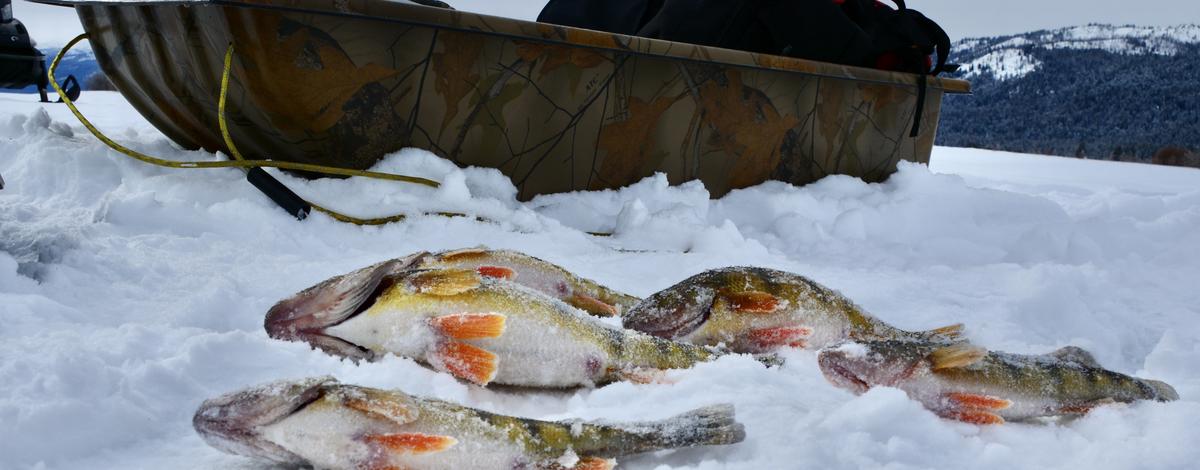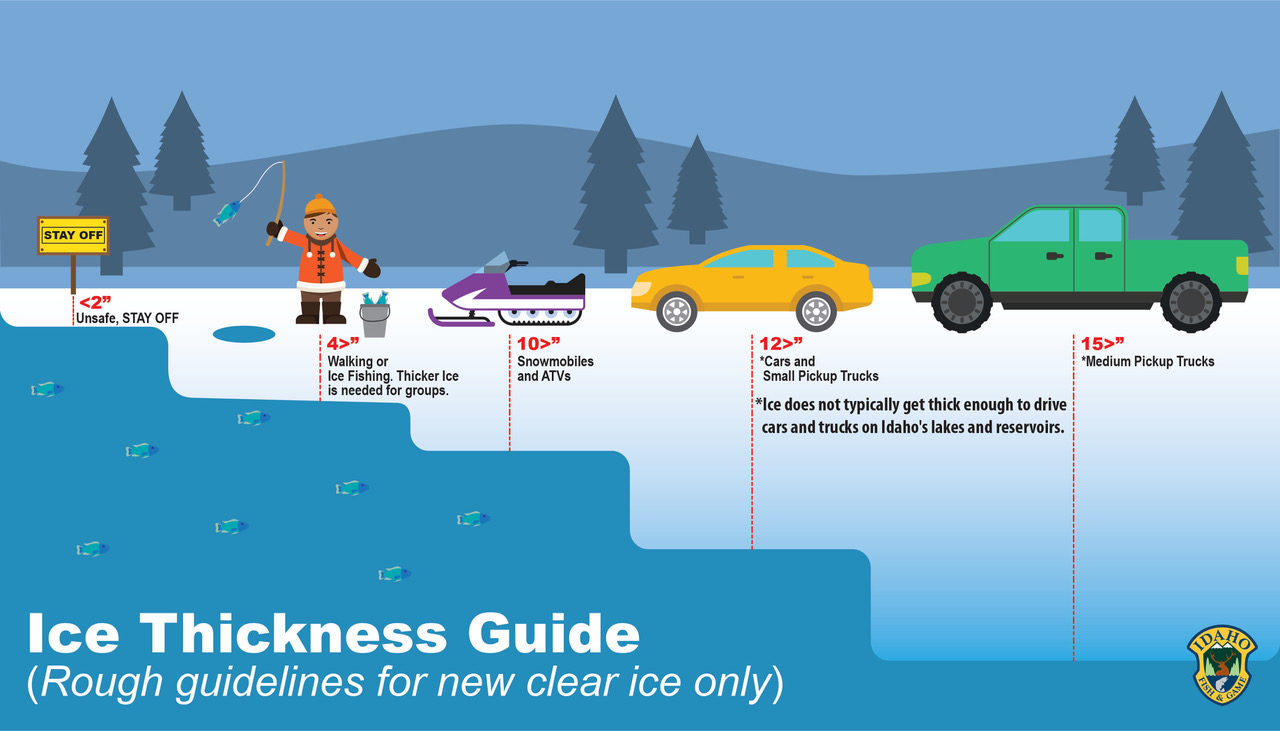Ice fishing can be pretty darned simple. Drill a hole, drop a baited hook and wait for a fish to bite. It really can be that simple if you’re just starting. But like all fishing, there are more ice fishing skills you can learn to catch more fish, and those skills can come from trial-and-error experience, or learning from experts.
If you're brand new to ice fishing and want to learn more, including ice fishing safety, see our ice fishing webpage.
It should come as no surprise that Idaho Fish and Game fisheries biologists like to fish, and they’re pretty good at it. Fortunately for novice and experienced anglers, they’re also willing to share their knowledge.

We asked biologists and other Fish and Game staff to share some of their best ice fishing tips to make your next trip more productive, and they delivered. So without further rambling, here they are:
Preparing to go and picking a fishing spot
Rig your rods and tip-ups while you are still at home. It’s always easier in the warmth of your house rather than on the ice. A five-gallon bucket works well to keep rods/tip-ups organized, and a sled is a great way to transport your gear onto the ice. Andy Dux, Panhandle Regional Fisheries Manager
Download a boating navigation app with maps of the lake you are fishing. Maps often show bottom contours of the lake (like a topographic map) so you can identify major features like points, humps, ledges or flats where fish might congregate. The map can also give you an estimate of the water depth. Martin Koenig, Sportfishing Program Coordinator
Checking depth with a lead depth finder, or some electronic depth finder and keep your bait within 12 inches of the bottom. When moving to a new location, refresh your bait, or changing jigs. Patrick Kennedy, Southeast Regional Fisheries Manager
Keep moving and drilling new holes unless the bite is steady. Fish often concentrate in one area, or move slowly in schools. You may catch a fish within the first few moments of fishing a new hole, and then you won’t catch anything else for a long time. You can return to the already-drilled holes later and try again to see if a new fish or school has moved into the area. Kevin Meyer, Principal Fisheries Research Biologist
If you’re unfamiliar with where you’re fishing and don’t know where fish are likely to be, start shallow and work your way to deeper water. Drill new holes every 15-20 minutes or so if you don’t get bites and keep going. Patrick Kennedy, Southeast Regional Fisheries Manager
Fish tend to bite better at the beginning of low pressure weather systems, so watch winter weather patterns and time your fishing trip with one. Eric Stark, Fishing/Boating Access Coordinator

Fishing tips
Whether fishing for trout, perch, or other species, try some jigs or hooks with bait, and some with only a jig head. And try different jig types to see if fish key in on a particular style or color. Sometimes the largest fish can be caught on the smallest of micro-jigs. Kevin Meyer, Principal Fisheries Research Biologist
Fishing with worms is always a good bet, but you only need a small piece (1-2 inches) to catch most panfish and trout. Cutting a worm into usable chunks is much easier with a small pair of scissors. Martin Koenig, Sportfishing Program Coordinator
Put out several tip-up rigs with a chunk of nightcrawler on a hook suspended a few feet under the ice in lakes with trout. It can be incredibly effective way to catch trout, and kids (and kids at heart) love to race for a flag when a fish hits it. Matt Corsi, Fisheries Research Manager
When it comes to terminal tackle, smaller is better. Use small hooks and small baits. Keep in mind that fish are not as active under the ice as they are during open water conditions. They are cold, and everything slows down including appetite. Also, the food available to fish under the ice is often small in winter, so stick to smaller offerings, which can still catch the lunkers. Brett High, Upper Snake Region Fisheries Manager
When you suspect there are fish around you, but don’t see them on the fish finder, try “ringing the dinner bell” by repeatedly dropping a jig into the muddy bottom of the lake to stir up as much mud as you can. It can wake up the fish and get them biting. Jordan Messner, Southwest Regional Fisheries Manager - McCall
Learn how to set up a couple of slip bobber set ups with micro jigs. Even kids can see the subtlest of bites. Joe Kozfkay, State Fisheries Manager
When fishing is on fire, it can be hard to manage multiple rods, but there’s no reason not to do it. But when the bite is slow, you can maximize your coverage by maximizing the number of rods you have out. The limit is five per angler. Kevin Meyer, Principal Fisheries Research Biologist
Use a double-surgeon’s knot to fish multiple hooks. This is a very easy knot to learn and is an easy way to add a second, or third hook without the need for extra tackle. Cut an 18-inch section off your line, and tie in the double surgeon’s knot. Then tie a jig to the “tag” of the surgeon’s knot that faces the end of the line. Add a second jig to the very end of the line below it. Fishing two smaller jigs on the same line can help reach the bottom quicker, and can help detect light bites by keeping the line a bit tighter. Plus, you can fish different colors, depths, or baits at the same time to figure out what’s working more quickly. Martin Koenig, Sportfishing Program Coordinator
If using multiple rods, actively fish one of them. Fish will often hit the jigged rod more than the stationary sets, but there are also times when a stationary presentation does better. Kevin Meyer, Principal Fisheries Research Biologist
Vary your jigging style from less active to more active, or bigger lifts to smaller lifts, until you find a movement pattern that seems to work best. Sometimes fish like to hit your jig when you are lifting it, so try frequently lifting the jig several feet at a time, then go back to the start and try again. Kevin Meyer, Principal Fisheries Research Biologist
Vary your depth of jigging; most people jig at or near the bottom, but there are times, especially with trout, when mid-column, or even surface fishing (just under the ice) works better. Kevin Meyer, Principal Fisheries Research Biologist
If you are fishing multiple rods and can only jig one of them, periodically switch which rod you are jigging, or at least make the rounds to move them all a little bit with a couple jigs of the rod. If one rod isn’t working well with active jigging, switch to actively jigging another rod. Sometimes you will see a bite on a stationary rod that you just jigged a few times and set back down. Kevin Meyer, Principal Fisheries Research Biologist
Vary the jigs between big and small, flashy, colorful, or drab. Tip these lures with different bait too, such as wax worms on one rod, night crawlers on another rod, then meal worms, power bait, etc. Patrick Kennedy, Southeast Regional Fisheries Manager
When attempting to land a big fish, stick your ice fishing rod into the ice hole to prevent the line from breaking off on the sharp ice at the bottom edge of the hole. Eric Stark, Fishing/Boating Access Coordinator

Tips for staying warm and comfortable
Bring a small hand towel to keep your hands clean and dry, which is key to staying warm. Drying your hands after drilling holes, cutting bait and handling fish will make a huge difference. Martin Koenig, Sportfishing Program Coordinator
Wear a ball cap or similar brimmed hat under a beanie. The bill from the ball cap will provide shade if it’s sunny, and help keep out snow off your face and eyes. Martin Koenig, Sportfishing Program Coordinator
A pop-up hunting blind is almost as good as a tent built specifically for ice fishing. Use a propane heater for extra warmth and to escape the wind. Joe Kozfkay, State Fisheries Manager
Single-use air-activated hand & feet warmers/heat packs to keep warm. They can extend your time on the ice, or help you warm up you get chilled. Patrick Kennedy, Southeast Regional Fisheries Manager
Bring a backpacking stove or similar small, portable stove. You can use it to make hot drinks or heat soup to help you stay warm, and also use it to dry and warm your hands if they get wet and cold. Roger Phillips, Public Information Supervisor

Other great ice fishing tips
Your smartphone is useful for many tasks. You can photograph your catch, and if fog or a snowstorm hits, you can also use it to call for help, or navigate back to your car. Just remember to keep it close to your body so the batteries don’t drain as fast. Martin Koenig, Sportfishing Program Coordinator
If you aren’t using a power auger, drill holes with a partner, standing on opposite sides of the auger and both doing the turning. Hand-drilled augers work great, but it is much easier to drill a hole with two people turning the auger than doing it solo. Even grade-school aged children can make a big power difference compared to drilling solo. Kevin Meyer, Principal Fisheries Research Biologist
Make sure you have one ice scooper per kid, or the little heathens fight over it all day. Joe Kozfkay, State Fisheries Manager
Ice fishing with your kids can be a lot of fun, and is a great way to get them outside in the winter months. Just remember that it’s about them, and not you. Besides dressing them in proper gear and bringing a pole for them, remember to bring good snacks, hot cocoa, and a fun, patient attitude. If the weather turns extra cold or windy, or fish aren’t biting, don’t be frustrated when your kids want to go home or do something else. They won’t always want to stay on the ice for hours on end like you might. Make it a positive experience, and they will want to go again and again. Jennifer Jackson, Southeast Regional Communications Manager


